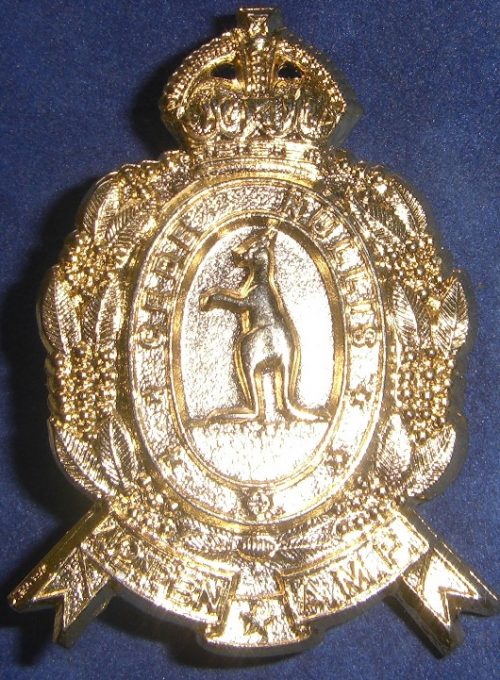Description
Description: 49th Battalion (The Stanley Regiment) – Oxidised Collar Badge Pair (Voided) – 1930 to 1942
Maker’s Name: N/A
Condition: Very Good
Comments: 49th Battalion (The Stanley Regiment) – Oxidised Collar Badge Pair (Voided) – 1930 to 1942
A scarce set of oxidised collar badges only worn from 1940 to 1942.
Guaranteed to be 100% genuine.
After the First World War the defence of the Australian mainland lay with the part-time soldiers of the Citizens Military Force, also known as the Militia. The Militia was organized to maintain the structure of the First AIF and kept the same numerical designations. The Militia units were distributed in the same areas in which the original AIF units were raised.
Queensland’s 49th Infantry Battalion was the Stanley Regiment. The 49th was raised in 1921, with its headquarters and a company in Kelvin Grove and companies in Toowong, Ipswich, and Ipswich-Lowood. It held its annual camp in the Redbank Plains area, west of Brisbane. In 1930 the 49th merged with the 25th Infantry Battalion to form the 25/49th Infantry Battalion. When the 25/49th separated in 1934 the 49th joined the 9th Infantry Battalion to form the 9/49th Infantry Battalion.
In February 1940 the 9/49th went into camp at Redbank and received its first quota of recruits called up for compulsorily national service. The 9/49th later moved to Chermside, a northern suburb of Brisbane, joining the 7th Brigade. In September 1940 the brigade became full-time and, after it was brought up to strength, separated from the 9th and remained with the 7th.
A new 49th was raised for tropical service in February 1941. The following month the battalion sailed to the islands as part of the convoy that took the 2/22nd Infantry Battalion to Rabual. Along the way the convoy stopped at Thursday Island and a group from the battalion, mainly from A Company, stayed to garrison the island. This group was initially called the 49th Battalion Details and in January 1942 became known as the Thursday Island Infantry Detachment. The rest of the battalion arrived in Port Moresby.
The battalion undertook little training in Moresby and mainly provided labour for working parties and unloaded ships stores. In 1941 the 39th and 53rd Battalions joined the 49th, forming the 30th Brigade. During this time the 49th’s morale was low and had reportedly the worst discipline in Moresby.
Japan entered the war at the end of the year and by the start of 1942 was rapidly advancing through south-east Asia and the Pacific. By March Japanese aircraft were attacking Moresby. The garrison at Moresby was strengthened to cope with the battles along the Kokoda Trail and at Milne Bay, yet there was little change to the 49th’s routine and their training remained basic. One veteran described the work as digging holes.
In September the 49th provided troops from the short-lived Honner Force, which patrolled the Goldie River to prevent the Japanese from cutting the Kokoda Trail between Ioribaiwa and Efogi. The remaining 49th provided support by patrolling the area around the Goldie-Laloki Rivers. By November morale within the battalion had improved with more combat experience and jungle training.
Having pushed the Japanese back across the Kokoda Trail, the 16th and 25th Brigades and two inexperienced American regiments were engaged in the battle of the beachheads at Buna, Gona, and Sanananda. The Japanese positions were well-prepared and heavily defended. At the end of November the 30th Brigade was flown across the Owen Stanley’s to reinforce the attack. The 49th and the 55/53rd Infantry Battalion went in action at Sanananda.
The 49th moved into position along the Sanananda Road on 6 December. Supported by the 55/53rd Infantry Battalion, its four companies, each about 100-men strong, attacked the next morning. Fortified and camouflaged, the Japanese fiercely resisted. One veteran, who also served with the 2/22nd in Rabaul and the 2/4th Infantry Battalion at Aitape, said he never saw a greater volume of fire than what was directed at the 49th on 7 December.
The attack failed and cost the 49th dearly. In five hours the battalion lost 14 officers and 215 men killed or wounded. Close to sixty per cent of the attacking force, just under half of the battalion’s full strength, were casualties. The 49th A Company lost nine men; B Company, 38; C Company, 11; and D Company, 60. Forced to continue fighting it lost a further 28 casualties in another unsuccessful attack on 19 December.
The battalion was finally relived in January 1943 and flown back to Moresby. Some members had been in Papua for nearly two years and many were not only exhausted but suffering from disease. Rest, recovery, and eventual further training were needed and the battalion returned to Australia in March, camping at Wondecla on the Atherton Tablelands.
In April the 49th participated in the 30th Brigade parade, with the 3/22nd and 39th Battalions. In May the 49th’s Militia personnel were posted to the 12th Brigade, where most went to the 36th Infantry Battalion. The 49th was reduced to just 20 officers and 146 men. Shortly afterwards they received news that the 30th Brigade was to be absorbed into the 16th Brigade. Virtually all of the remaining 49th personnel merged with the 2/1st and on 3 July the 49th was disbanded.




